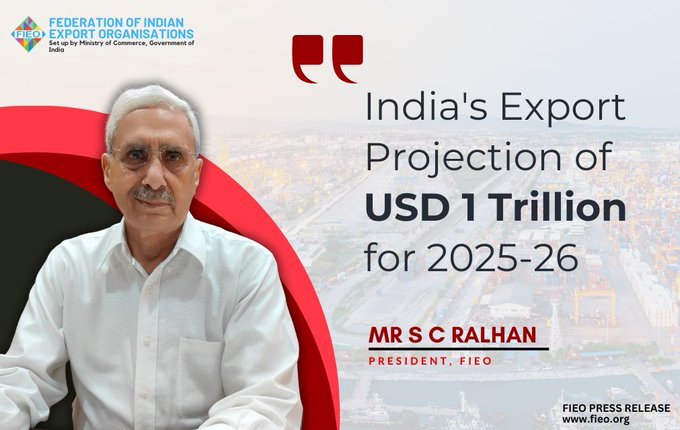
India’s export projection of USD 1 Trillion for 2025-26 : President, FIEO
NEW DELHI : Mr. S C Ralhan, President, FIEO stated that, India’s export sector achieved a significant milestone in the fiscal year 2024–25, with total exports reaching a record $824.9 billion, marking a 6.01% increase from the previous year’s $778.1 billion. This growth was propelled by:
a. Services Exports: Surging 13.6% to $387.5 billion, driven by strong performances in IT, business, financial, and travel-related services.
b. Merchandise Exports: Reaching $437.4 billion, with non-petroleum goods exports hitting a record $374.1 billion, up 6% from the previous year.
We are aiming at an export of US$ 1 Trillion by the end of the fiscal with Merchandise exports of US$ 525-535Bn (Growth of about 12%) and Services exports of (US$ 465 -475 Bn with Growth of about 20%)
Strategies to Enhance Future Export Performance
To build upon this momentum and achieve sustained growth in both goods and services exports, the following strategies are recommended:
- Diversification of Export Markets: Expanding into emerging markets and strengthening trade relations with existing partners can mitigate risks associated with over-reliance on specific regions.
- Promotion of Value-Added Products: Shifting focus from raw materials to value-added products can increase export earnings and reduce vulnerability to price fluctuations in global commodity markets.
- Strengthening Trade Agreements: Negotiating and implementing Free Trade Agreements (FTAs) with key partners can facilitate easier market access and reduce trade barriers.
- Enhancement of Export Competitiveness: Investing in quality infrastructure, reducing logistics costs, and ensuring compliance with international standards will improve the competitiveness of Indian exports.
- Support for Small and Medium Enterprises (SMEs): Providing SMEs with access to finance, and market information will enable them to participate more effectively in international trade.
- Adoption of Digital Technologies: Leveraging digital platforms for marketing, sales, and customer engagement can open new avenues for exports, particularly in services sectors.
By implementing these strategies, India can enhance its export performance, contributing to economic growth and positioning itself as a formidable player in global trade.
Rising Protectionism and NTMs:
The global trade landscape in 2025 is increasingly characterized by a resurgence of protectionist policies, marking a significant shift from the liberalization trends of previous decades. This protectionism manifests through heightened tariffs, non-tariff barriers (NTBs), and strategic trade measures, impacting global commerce and economic stability. The number of import restrictions among G20 economies has soared to 4,650 — up 75% since 2016 and nearly 10 times the number in place in 2008. In early 2025, the U.S. escalated its trade measures by increasing the average effective tariff rate from 2.5% to an estimated 27%, the highest in over a century. EU is focussing on NTMs based on environment and sustainability to put pressure on MSMEs. While some NTMs serve legitimate regulatory objectives, many are turning into Non-Tariff Barriers (NTBs) when used to discriminate or create disguised protectionism.
Three of the most prominent EU regulations illustrating this shift are:
- EUDR (EU Deforestation Regulation)
- CBAM (Carbon Border Adjustment Mechanism)
- ESPR (Eco Design Sustainable Product Regulation)
All the three will come into force from 1st January, 2026 . The ESPR framework is implemented through Digital Product Passport providing complete traceability of product throughout its lifecycle.
Digital Product Passport:
The Digital Product Passport (DPP) is a transformative regulation being introduced by the European Union (EU) under its Green Deal and Circular Economy Action Plan. The DPP aims to digitally record, store, and share information about a product’s entire life cycle—from raw materials to manufacturing, usage, recycling, and disposal.
DPP basically depict the lifecycle of every product sold in the EU. This passport include:
- Material composition and sources (e.g., recycled content)
- Carbon footprint and energy use
- Repairability and recyclability
- Compliance with environmental and social standards
- Certifications and regulatory compliance
- End-of-life instructions
It will be mandatory for a wide range of products, starting with sectors like electronics, batteries, textiles, and construction materials from 1st Jan, 2026 with wider rollouts expected by 2026–2030.
India is a major exporter to the EU across several sectors that will be directly impacted by the DPP. The DPP could affect Indian exporters, especially MSMEs:
1. Increased Compliance Burden
MSMEs will need to digitally document every stage of the product life cycle, including sourcing, energy use, and end-of-life impact—something many are not currently equipped to do.
2. Risk of Market Access Barriers
Non-compliance with DPP requirements may lead to rejection of consignments or loss of competitiveness in the EU market, which is becoming increasingly sustainability-focused.
3. Cost of Digital Integration
Creating and maintaining digital passports may require investment in technology, software, and expertise, which could be burdensome for small exporters.
4. Need for Transparency
Indian exporters will have to ensure full supply chain traceability—something currently lacking in many traditional sectors like textiles, leather, and electronics.
Initiative by the Government and FIEO/EPCs
We request the Government to create sector-specific task forces to study DPP requirements and build compliance roadmaps and develop a national framework or digital infrastructure that can help exporters generate DPPs efficiently. The Government may also provide assistance or grants to MSMEs to adopt traceability and product lifecycle management systems.
FIEO, EPCs (Export Promotion Councils), and MSME Ministry should run extensive capacity-building programs to educate exporters about: Product sustainability, Digital traceability tools and EU regulations and expectations
The Digital Product Passport is not just a regulatory requirement—it’s a shift towards sustainable, transparent, and digital trade. For India, especially its 6.3 crore MSMEs, this could be a challenge but also an opportunity to upgrade manufacturing processes, embrace green technologies, and increase global trust in Indian products.
